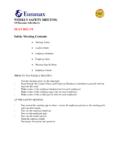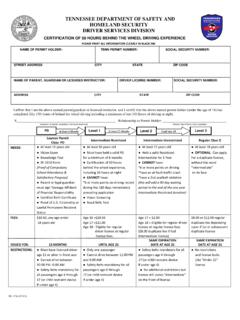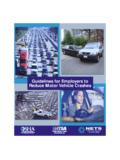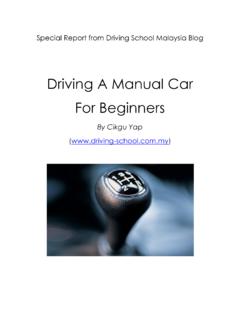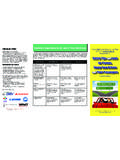Transcription of CT DMV Driving School Two Hour Parent Training …
1 CT DMV Driving School Two hour Parent Training standards August 1, 2008 Introduction Changes in the law affecting 16/17 year olds who receive their Learner Permit on or after August 1, 2008 require parents to attend a two hour class to be given by Commercial Driving Schools. CT DMV is providing the following standard for such Training . Purpose The class is to educate parents /guardians about the graduated licensing law including passenger and curfew restrictions; the dangers of teenage Driving , the risks inherent in allowing teenagers to drive due to the cognitive development of adolescents, and the responsibilities and liabilities of parents of teenage drivers. In addition, the class will include a discussion and provide tools for parents /guardians to develop their own skills and behaviors to better prepare parents to model appropriate skills while instructing and Driving with their teenagers.
2 The goal of this class is to assist parents /guardians to coach and mentor their teenagers into safe and skilled drivers. Objectives By the end of the class, parents should be able to: 9 Explain the graduated licensing law and the Parent /guardian s role in supporting the law 9 List the Driving skills their child must master to pass a road test 9 Identify the driver s education class modules and the relevance to developing good Driving skills 9 Provide examples of Driving behaviors to avoid because they may negatively influence a new driver 9 Understand and exhibit safe Driving skills as a role model as they coach their teen to become a safe and skilled driver Topic Outline 1) Driver s Education Overview a) Purpose and class structure b) Expectations c) Curriculum modules 2) Graduated Licensing Law a)
3 Driver Manual Supplement CT DMV Driving School Two hour Parent Training Curriculum Standard Page 2 Rev. 8/1/08 3) Necessary Driving Skills and Behaviors a) Dangers of teen Driving b) Teen Crash and Fatality Statistics i) Auto crashes - first-ranking cause of teenage fatalities ii) 6,500 fatalities per year nationwide iii) Compare probability of teen car crashes to other probabilities iv) Highest risk of crashes for teens in the first few months of Driving c) New Driver Patterns: i) Driving as a complex skill (1) Requires vehicle control and placement; vigilance for routine traffic elements (signs, signals, road conditions, other vehicles, pedestrians) and appropriate adjustments.
4 Anticipation of possible unseen or quickly developing hazards and safe responses ii) Value of experience (complex skills become automatic ) iii) New drivers must focus and concentrate (1) New drivers cannot perform the complex skills as well as experienced drivers (2) Distractions or impairment degrades Driving performance more than for experienced drivers d) Key risks: i) Inexperience ii) Night Driving iii) High speed iv) Teen passengers v) Other distractions (radios, other electronic devices) e) Basic rules for crash avoidance/injury minimization i) Follow laws, passenger limits, curfews, and drive defensively ii) Wear seat belts keep you in position, cut risk of fatality by about half in a serious crash iii) No alcohol or other drugs any amount of alcohol reduces ability to drive safely iv) Avoid distractions passengers, especially friends.
5 No cell phones of any kind or portable electronic devices ( , iPods); radios, navigation equipment, other 4) Cognitive development of adolescents a) Brain Development: Brain not fully mature until early 20s b) Judgment and decision making last to develop c) Risk taking is frequent consequences not internalized d) Self control is developing CT DMV Driving School Two hour Parent Training Curriculum Standard Page 3 Rev. 8/1/08 Hazard awareness i) Introduction Failure to anticipate hazards represent over 30% of crash causation ii) RAPT-3 Hazard Awareness / At-home Training exercise (a) Introduce, explain, recommend parental & teen joint review and use of RAPT-3 as an at-home exercise (b) Refer to DMV website link to RAPT-3 (c) home or public library computer use 5) Parent s Role.
6 Responsibilities & Liabilities i) Financial Liability for Crash Damages (1) Recommend parents notify insurance carrier of teen driver / confirm adequate coverage due to parental liability for teen crash resulting in personal injury/property damages above insurance policy limits (2) Recommend against providing Teen with performance vehicles consider low horsepower for teen drivers ii) Coaching and mentoring / Parent as role model (1) Follow the traffic laws (2) Be a patient, courteous driver iii) Supporting teen Driving law (1) Avoid describing restrictions in derogatory terms (2) Avoid focus on parental inconvenience, focus on the intent of teen safety (3) Agree to set family rules regarding Driving , as a Learner and as a New Driver (a) comply w/ passenger & curfew (b) get permission before leaving, file a flight plan (c) call if changes in flight plan (d) set Driving limits: , types of roadways, seat belts, no distractions, no alcohol or drugs iv) Parent /Student Driving Log (1) Log provides subject guidelines for Driving practice (2) Build on experience, introduce challenges in stages (3) Avoid giving the same 1 hour behind-the-wheel Training 40 times 6) Reference Materials i) DMV website: (a) List of references (books, websites, etc.
7 (b) Parent /Student Driving Log












